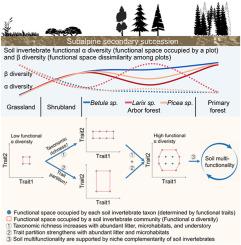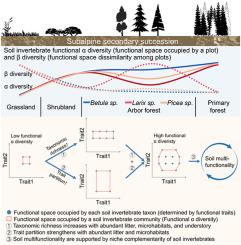分类组合和性状分配对高海拔高原生态系统土壤无脊椎动物次生演替的功能多样性贡献较大
IF 10.3
1区 农林科学
Q1 SOIL SCIENCE
引用次数: 0
摘要
被砍伐的森林和被遗弃的土地经历了广泛的次生演替。然而,在演替过程中,土壤无脊椎动物群落中功能多样性的出现,特别是分类组合和性状划分在其驱动中的相对作用尚不清楚。为了解决这一问题,我们开发了一种新的“分类多样性-功能距离”分析方法,并将其应用于高海拔次生演替梯度下的土壤无脊椎动物群落,包括次生草地、灌丛、乔木林和原始林(顶极)林。结果表明,土壤无脊椎动物功能α多样性(样地内功能丰富度)随演替的增加而增加,但在乔木林期随树种的不同而有所波动。功能β多样性(样地间功能不相似性)随演替而下降,支持收敛演替模型。分类α/β多样性(分类丰富度/不相似性)和功能α/β距离(小区内/小区间性状划分)共同塑造了观测到的功能α/β多样性,且贡献相当。凋落物和土壤微生境通过分类多样性和性状分配形成功能多样性,从而支持土壤多功能演替。我们的研究结果通过确定无脊椎动物功能的双重恢复途径,推进了基于性状的土壤无脊椎动物生态学。他们强调性状划分是分类组合的一种机制补充,两者在驱动土壤生态系统功能方面都有相当的贡献。将这些机制的测试扩展到生物群系和空间尺度,将为有针对性的生态系统管理提供信息,增强土壤生物保护在全球恢复中的功能效益。本文章由计算机程序翻译,如有差异,请以英文原文为准。


Taxonomic assembly and trait partitioning contribute comparably to soil invertebrate functional diversity along secondary succession in high-elevation plateau ecosystems
Deforested and abandoned lands have undergone extensive secondary succession. However, the emergence of functional diversity in soil invertebrate communities along the succession, particularly the relative roles of taxonomic assembly and trait partitioning in driving it, remains unclear. To address this issue, we developed a novel “taxonomic diversity-functional distance” analytical approach and applied it to soil invertebrate communities across a high-elevation secondary successional gradient, including secondary grassland, shrubland, arboreal forest, and primary (climax) forest. We found that soil invertebrate functional α diversity (functional richness within plots) increased overall with succession, although it fluctuated with tree identity in the arboreal forest stage. Functional β diversity (functional dissimilarity among plots) declined over succession, supporting the convergent successional model. Both taxonomic α/β diversity (taxonomic richness/dissimilarity) and functional α/β distance (trait partitions within/among plots) jointly shaped observed functional α/β diversity, with comparable contributions. The litter and soil microhabitats shaped functional diversity via taxonomic diversity and trait partitioning, thereby supporting soil multifunctionality succession. Our results advance trait-based soil invertebrate ecology by identifying dual recovery pathways for invertebrate functionality. They highlight trait partitioning as a mechanistic complement to taxonomic assembly, with both making comparable contributions to driving soil ecosystem functioning. Extending tests of these mechanisms across biomes and spatial scales will inform targeted ecosystem management, enhancing the functional benefits of soil biology conservation in global restoration.
求助全文
通过发布文献求助,成功后即可免费获取论文全文。
去求助
来源期刊

Soil Biology & Biochemistry
农林科学-土壤科学
CiteScore
16.90
自引率
9.30%
发文量
312
审稿时长
49 days
期刊介绍:
Soil Biology & Biochemistry publishes original research articles of international significance focusing on biological processes in soil and their applications to soil and environmental quality. Major topics include the ecology and biochemical processes of soil organisms, their effects on the environment, and interactions with plants. The journal also welcomes state-of-the-art reviews and discussions on contemporary research in soil biology and biochemistry.
 求助内容:
求助内容: 应助结果提醒方式:
应助结果提醒方式:


